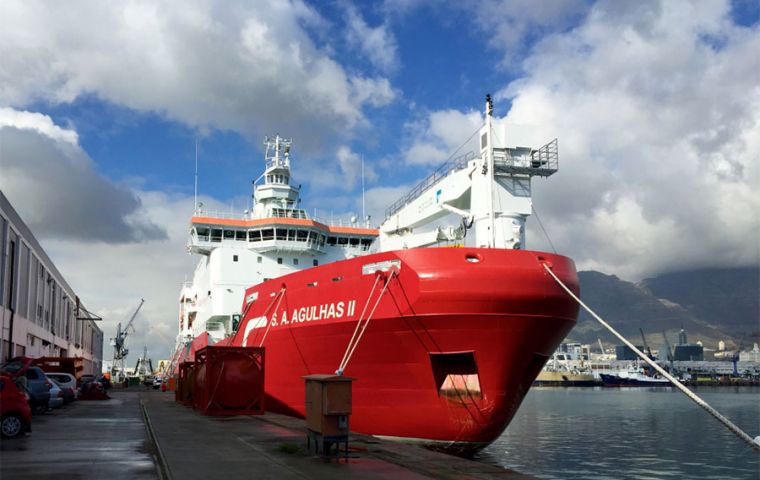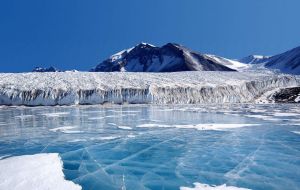MercoPress. South Atlantic News Agency
Falkland Islander in expedition to locate Shackleton's stricken “Endurance” in Antarctica
 The 45-day expedition set sail on the South African icebreaker SA Agulhas II with the primary goal to study the A68 iceberg, which calved from the Larsen C ice shelf
The 45-day expedition set sail on the South African icebreaker SA Agulhas II with the primary goal to study the A68 iceberg, which calved from the Larsen C ice shelf  The iceberg has been measured to have an area of 5,800 square kilometers, larger than West Falkland, is thought to weigh one trillion tons.
The iceberg has been measured to have an area of 5,800 square kilometers, larger than West Falkland, is thought to weigh one trillion tons.  It is on the expedition’s return leg that the team will aim to find Shackleton’s legendary ship, Endurance, crushed by pack and sank
It is on the expedition’s return leg that the team will aim to find Shackleton’s legendary ship, Endurance, crushed by pack and sank An Antarctic scientific expedition aiming to understand the secrets of a giant iceberg will also attempt to locate Ernest Shackleton’s stricken Endurance in the Weddell Sea, according to reports in The Guardian.
The expedition also includes Falkland Islands born and raised Mensun Bound, marine archeologist, who recently was involved with the Seabed Constructor in helping to discover the lost Argentine submarine, ARA San Juan.
The 45-day expedition set sail on the South African icebreaker SA Agulhas II this week.
Its primary goal will be to study the A68 iceberg, which calved from the Larsen C ice shelf in 2017. The iceberg has been measured to have an area of 5,800 square kilometers, - some 1,300 square kilometers larger than West Falkland - and is thought to weigh one trillion tons.
It is on the expedition’s return leg that the team will aim to find Shackleton’s legendary ship.
Speaking to the Guardian, Julian Dowesdell, director of the Polar Research Institute, in Cambridge, said, “Antarctica is a place of extremes, you never know what conditions will be like... But if we are that close to one of the most iconic vessels in polar exploration, we have to go and look for it.”
Attempts to find the vessel will nevertheless hinge on pack ice conditions. It is expected that the Agulhas II will have to break its way through the ice for some days before reaching the location.
Once at the spot where the Endurance was crushed by pack and sank, the water will need to be clear enough so that the vessel’s robotic underwater vehicles can be safely launched.
“We’d love to get to the wreck site, but it will be a challenge even in a light ice year,” John Shears, the expedition’s voyage leader, told the Guardian “No one has ever got close. If it was easy to do then someone would have done it a long time ago,” he said.
The expedition’s primary mission will aim to understand the wider picture surrounding the calving of the massive iceberg.
The team’s robotic submarines will scan both the sea bed and the underside of the ice shelf with sonar. In scanning the seabed, the team will look for iceberg scours or “plough-marks.”
Absence of these scours will suggest that the calving of such icebergs is a relatively new phenomenon.
Sonar scans of the underside of the ice shelf will attempt to detect cavities where the ice has been melted by the warmer sea water underneath. That data will be fed into models along with sea temperature and salinity data to determine ice shelf melt rates. Ice shelves play an important part in preventing sea level rise, as they act as buttresses slowing glaciers’ flow into the sea. (Penguin News).




Top Comments
Disclaimer & comment rulesCommenting for this story is now closed.
If you have a Facebook account, become a fan and comment on our Facebook Page!